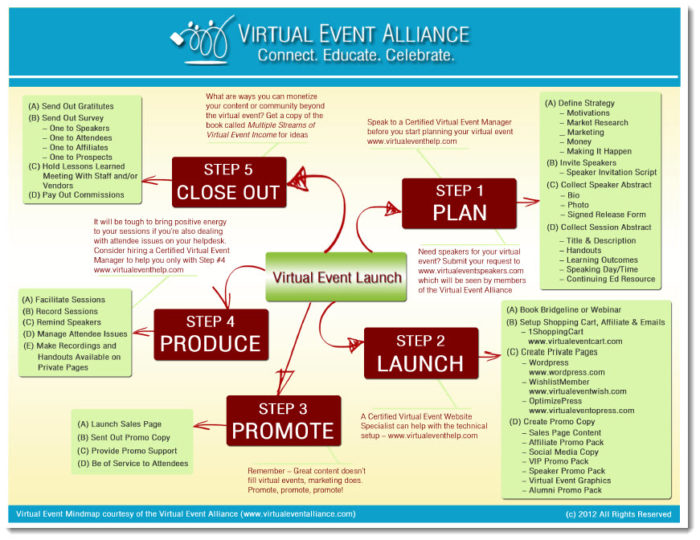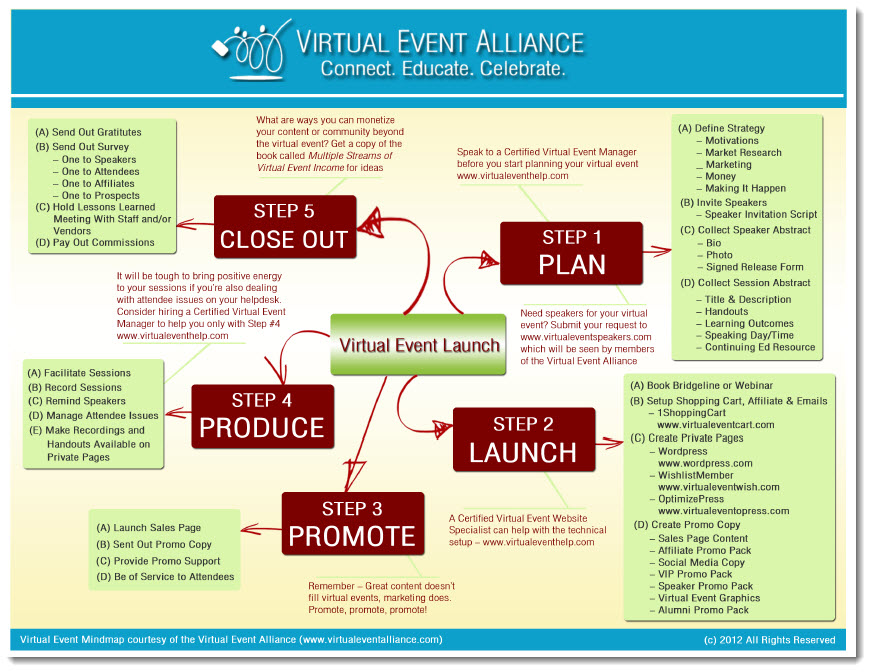I hosted and produced my very first telesummit in 2008.
Thirty-six speakers over eight days. It was massive. I also earned just below $20,000 in registration fees and added 5,000 emails to my list. I hosted the event again in 2009 and 2010.
Then, in 2010, I helped my first client with his very first telesummit…
When we met, he told me he had been thinking of hosting a virtual summit for quite some time – he just couldn’t be bothered with all the particulars in launching one.
Soon, other virtual summit clients came knocking…
I was producing at least 10 virtual summits per year. Choice Magazine called me the “Go to Person for Virtual Event Know How.”
For those who could not afford my virtual summit consulting rate (it’s five figures + a percentage of revenue), I created a few homestudy programs to help bridge the gap. These include:
- Telesummit Host Tips – To help hosts understand how to interview guests for success
- Virtual Event Marketing Blueprint – An eight module program outlining how to promote a virtual event because “great content doesn’t fill virtual events; marketing does”
- Virtual Event Minisite – How to use WordPress and a few choice plugins to support your virtual event
- Virtual Event Planning Guide – The 5 Ms to help you plan a successful virtual event
I have calculated that a virtual summit can take 125-250 hours to produce…
There are so many moving pieces. I put together this mindmap years ago to show what’s involved in bringing a virtual summit to market (see image below – most links in the image do not work).

Soon, the demand outstripped supply…
I was getting more people inquiring about my production services and I hated turning business away. So, I decided to certify virtual assistants in my five-step process. That way, I could refer business their way.
So, I created the Certified Virtual Event Manager’s training system. It was a 12-week process where they received training and shadowed me or another senior virtual event producer on a real, live virtual summit.
After they graduated, the certified professional became a member in the Virtual Event Alliance. Through the alliance, prospects could submit their request for help and the certified professionals could bid on those requests.
It was a brilliant system…
It worked for about two-years, but there were two problems which emerged:
- I couldn’t provide the mentorship to the certified professionals because I couldn’t give up the virtual summit production. In essence, I was competing against those whom I certified. Most times, the prospect would choose me over my certified professionals because I (naturally) had more experience.
- The number of requests for help started to dry up. Instead of receiving dozens of requests per month, I was now getting dozens of requests per quarter, and then eventually, twice per year. It was hard to convince someone to invest in certification when the demand just wasn’t there.
So, in 2014, I closed down all my training programs and went back to focusing exclusively on producing virtual summits…
I removed the self-paced courses from my website and I stopped certifying virtual assistants in my process. I now refer people to these excellent virtual summit and telesummit trainers (here, here, and here). They teach you how to do it yourself.
After trying to teach the virtual summit process, I now focus exclusively on producing virtual summits.
Producing virtual summits is way more fun because I actually see them to completion…
When I was teaching business leaders how to produce their virtual summits, less than 12% of those who invested in the self-paced course actually went on to host their virtual summit.
When my team and I handled all the administrative and technical tasks associated with producing a virtual summit, 86% of my virtual summit consulting clients hosted their virtual event.
One of my clients, who’s hosting his eighth one in 2017, has grown his business from six-figures into seven figures just by hosting an annual virtual summit. I’ve enjoyed watching his business grow over the years and he regales me with stories of his mistakes and successes.
Since 2008, I’ve also discovered who’s the best candidate to hire a virtual summit production team…
- You must have revenues in the multiple six-figures to seven-figures. When you’re here, hiring a team to produce your virtual summit is a no-brainer because you recognize that your time is best spend on other tasks.
- You must have a sales funnel where you know your numbers (eg. you know that 12% of those who enter your sales funnel become clients – that sort of thing)
- You must have an audience. It could be 500 or 500,000, but you must have one that you’re ready to monetize.
- You must already know what virtual summits are and what potential they may have in growing your business. Maybe you invested in a telesummit or virtual summit course and get what it can do. You just need someone to take care of all the moving pieces.
- You must have some consultants or employees working in your business. My best clients have a marketing professional or PR team, a sales consultant, or virtual assistant (administrative or techie) already working with them. The goal isn’t to bog them down with virtual summit tasks, but to make their job easier since my team will be doing this work for them.
- You must have a clear niche. Business owners isn’t a clear niche. Law firm owners is. Recruiting business owners is. Fitness facility owners is. You get the point.
If you meet the six points above, let’s have a conversation…
I’d be happy to hear your goals and how you believe a virtual summit can help you get there. If I believe I can help you meet those goals, we can continue the conversation. Click here to book a time with me.
PLEASE NOTE: This isn’t a “pick Leesa’s brain” session. If you need to be convinced that you should host a virtual summit, or if you’re in the middle of hosting one and it’s not going well, or if you’re puzzled who you can target using a telesummit, I can’t help you. You’ve got to be clear because that’s the only way you’ll succeed.


0 Comments